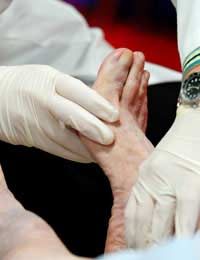Foot Ulcers

Foot ulcers can develop in anyone and can range from inflammation of the skin to very extensive sores that can become very deep and large.They can be extremely difficult to heal once they have become established and are frequently seen in those suffering from diabetes, vascular disease or in the elderly.
Why do Foot Ulcers Develop?
There are many reasons why an ulcer may develop on the foot with the most common reasons being due to poorly controlled diabetes, heart disease or vascular disease.The ulcer occurs as a result or poor oxygenation of the tissues of the foot as this is the furthest part of the anatomy from the heart so receives the blood pumped from the heart later than other parts of the body.Ulcers can be of an arterial or venous origin, each having its own physiological causes.Arterial ulcers are caused by narrowing of the arteries of the lower limbs and this narrowing is usually due to smoking, obesity, high blood pressure or heart disease, which lowers the oxygen levels in the blood, and therefore the foot.
Venous ulcers are caused by poor function of the valves within the veins of the lower leg and foot; the purpose of these veins is to push the blood back through the vessel allowing the blood to be re-oxygenated and re-circulated, if the valves do not work properly, the blood is allowed to collect and thicken within the vessel.
Other reasons for foot ulcers developing include trauma, infection, nerve damage or tumours; your GP will always want to discover the underlying cause of the ulcer in order to treat both the ulcer effectively and any other condition you may have.
Signs and Symptoms of a Foot Ulcer
In their early stages, the ulcers may begin as a slight discolouration of the skin, often with a blue or grey tinge to the skin.Venous ulcers commonly begin with a swelling of the foot or lower leg, with the skin taking a shiny and stretched appearance that is often accompanied by weeping fluid from the swollen area.As the ulcer progresses, the skin can break down and continue to deteriorate, often fairly quickly until the deep layers of tissue are affected. As the tissue becomes damaged and dies, pain levels vary as nerves can become damaged also.
Treatment of Foot Ulcers
There are a wide variety of treatment options available, which all depend on the cause of the ulcer. Primarily your GP will want to determine the cause of the ulcer and treat this as a priority as you may be suffering from a potentially dangerous heart or vascular condition. If you suffer from diabetes, the management of your condition will be assessed to find out if it could be controlled any better to prevent ulcers occurring elsewhere or recur.The ulcer itself will normally be treated by the practice nurse or by the community nurses who will use dressings and techniques developed specifically for ulcers of a venous or arterial nature. This often requires frequent redressing of the wound using a variety of cleansing techniques and compression bandages.
You will normally be required to keep the affected limb elevated when resting, above the level of the heart if possible to allow fluids to drain away and reduce swelling.Anti-inflammatory medications will often be prescribed along with pain relief, though many only take this before their dressing changes as this tends to be when the most pain is experienced.
Prevention of Foot Ulcers
Many people can prevent a foot ulcer from developing by being sensible about their lifestyle. Stopping smoking, eating a healthy diet and keeping weight within a healthy range are sometimes all it takes to keep the vessels of the lower leg healthy and free from disease.For those with a diagnosed condition such as diabetes, it is essential that all advice given by the professionals is followed and that the condition is being successfully controlled. Diabetes is a very individual disease and it may take each person a long time to develop a lifestyle that controls it successfully, which may then need adjusting as age advances.Avoid crossing the legs when sitting down as this can damage the veins in the legs and cause blood to pool, elevate the limbs when resting if able and appropriate instead.Maintain good foot hygiene practices and ensure the foot is dried properly after bathing to prevent fungal infections from developing and ensure a good nail care regime, especially if you have an underlying disease such as those mentioned.
Correctly fitting footwear is essential is protecting the feet from injury and if a blister or sore does occur from ill-fitting shoes, treat these immediately and monitor their progress.
Business Energy With a Difference
If you are looking for business energy or need advanced solutions like remote energy monitoring, new supplies, downgrading or upgrading capacity, have a no obligation chat with Purely Energy.
To find our more get in touch here. or call 0161 521 3400.







